|
This is one of the oldest pages on piquaclimber.com. In an effort to keep some perspective, I have left anything from before 2000 in it's original format. |
Pear Buttress 5.8+, Lumpy Ridge, Rocky Mountain National Park
This is another climb that I
did with Lisa a couple months ago. The climb is
called Pear Buttress and is
located on a formation called The Book which is
on Lumpy Ridge in Rocky
Mountain National Park. It was a stellar day and a
breakthrough day for me in
terms of leading.
It is a curious thing the way climbers push themselves when it
comes
to leading. There are two
major components that play a role. Physical
ability and Mental Strength.
Physical ability determines whether or not you
are capable of doing the
moves required to get up the wall. (i.e. can you
hang from three fingers off
a 1 inch ledge or can you jam your hand in a
vertical crack and twist it enough
to provide sufficient friction so that
your hand won't pull
out) Mental strength is the ability to
remain calm and
focused even though you know
you are in a potentially dangerous situation
and you feel like you could fall at any moment.
Most climbers have a stronger physical ability than mental strength. (The
ones that don't aren't around long.) That basically means that they don't
want to lead climb at the limit of their physical abilities. (NOTE: see the bottom
of this text for a description of "lead" climbing.) Having said all that,
when I climbed Pear Buttress, I had never led a climb that was rated over 5.7 so
I was am little nervous. I had
followed 5.10 routes though so I knew that my physical
ability was up to the
challenge. To compound the matter further, I had just
become comfortable leading
well protected 5.7 routes and this route had a
5.7 start that goes up 25
feet from the ground without the possibility of
placing protection.
Translation: DON'T fall before you get some pro(tection)
in. It is amazing how much
easier it is to lead a section of 5.7 when you
know you won't hit the
ground than it is when you know you only get one
chance to pull it off. This
day, I planned to push myself mentally and see
how I reacted to being on
terrain that was perfectly within my abilities,
but offered no pro. It does
not help that the start of this route has a long
history of broken ankles.
None the less, Lisa and I met at the Twin Owls
trailhead at 8am, sorted gear, and headed down the trail toward The Book.
When we got there, a couple of Lisa's friends were already at
the
base of the route that we
planned to do. They graciously offered to let us
go first but we declined,
thinking that they would climb faster that us and
not wanting to feel rushed.
This is where my mental strength almost failed
me before we even started.
As I said before, the start is unprotected for 25
feet. Les, (Lisa's friend)
offered to place the first piece of gear for us
and clip my rope through
that piece of gear which would have made the climb
much safer but would not
offer me the chance to push my mental limits. I had
a real internal struggle
going on as he started up... (should I let him clip
that piece of pro for me? I
will feel so good if I do it all myself, I can
do it, I won't feel too good
if I have to call someone up here to haul my
ass back to the trailhead
with a broken ankle., I want it, is it worth the
risk...) He got to where he
needed to be to place the pro for me and I said,
"we're good... see ya
on top." He left and I went back to looking at the
start and trying to work out all the sequences in my head.
Finally they were off the first pitch and I was free to start
up. I
tied in and began climbing.
The climbing seemed a little stiff for 5.7 but
that was probably due to the
lack of protection. After a few minutes I had
worked myself up about 18
feet and was standing on the last good hold. There
was another fairly good hold
in my right hand but my arm was fully extended
to reach it and I had to get
my feet on that upper hold before I could place
any pro. From here it required a little delicate
footwork and balance to
move up the rock and get my
feet into position. After what seemed like 10
hours, I committed to the
moves and was soon standing on the little hold and
placing pro. ( I was feeling
GOOD! :) The rest of the pitch climbs the right
side of a huge flake. Once
on top of the flake, (this flake is about 50 feet
tall, 25 feet wide and 4
feet thick) there are two finger cracks that lead
up to a nice ledge. These
finger cracks are the crux of the route. They are
only about 1 inch wide.
Fortunately, I could place great protection from the
top of the flake so when I committed
to the moves, it was with the knowledge
that if I fell, It would not
be bad at all. I fired the moves and was
quickly at the
ledge. I
can't express enough how helpful it is on pitches
like that to have a partner
that you trust. Lisa was great, she did not rush
me, told me several times
that if I did not want to do this, she was more
than happy to climb
something else; and most importantly she kept saying,
"You can do it Brad. I
know you can." It may sound trivial, but it really
makes a difference.
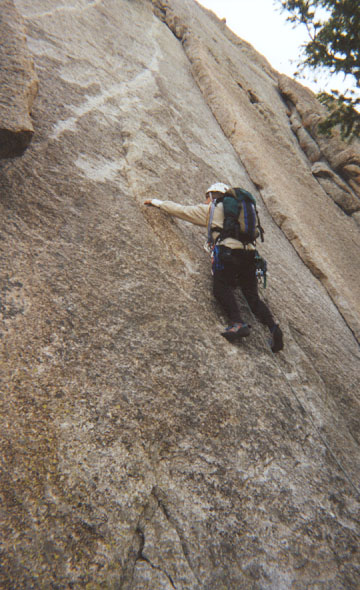
(The flake that takes the pro is
on the left)
The next pitch was about the same for Lisa as the first one had
been
for me. She knew she could
climb it, but we were over 100 feet off the deck
and she is was new to
leading. However the description said that it was only
5.4 so she headed off on a
ramp and around a corner and out of sight. I
heard her yell a few times
and then I saw her well above me at the next
belay. When I arrived, she
asked me if I though the pitch was 5.4. "Nope, at
least 5.6" was my
response. She had done a terrific job of dealing with
whatever was thrown at her
and getting to the top. Especially since she was
around a corner and out of
sight so she was basically alone when dealing
with the difficulties.
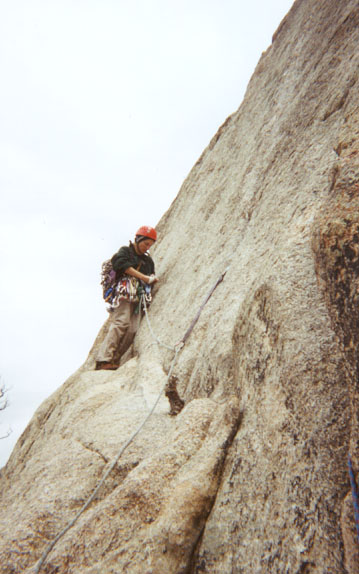
(This pitch goes around the corner that is behind Lisa)
Now we were standing on a nice ledge looking at a crack that
shot up
the wall for 100 feet or
more. I was a little intimidated but the protection
was there anywhere you
wanted it so I placed a piece of pro and started up.
There were great hand jams
(stick you hand in a vertical crack, turn it
sideways to "cam"
it in the crack, put your toes in the crack, and move up)
It was a little tricky at
first but there were good resting spots all the
way up and after some time,
I was at the top of the crack where I had to
traverse under a small roof to the belay.
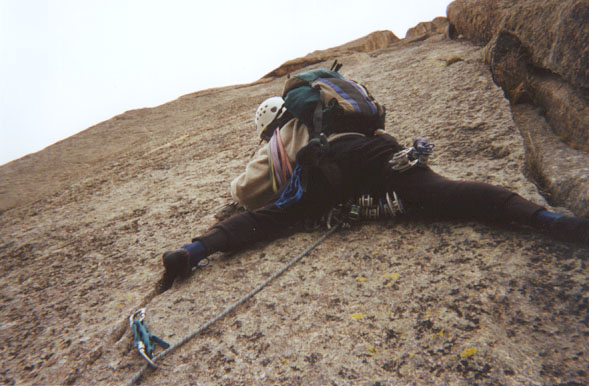
(The crack that my left foot is in is the 100 foot crack)
I brought Lisa up and she headed up the next pitch which turned
out
to be the easiest pitch of
the climb. She cruised up to the base of the last
pitch.
The last pitch is called The Cave because you go way back in
this
alcove and you have to climb
out under a roof for about 6 feet, turn the
roof, and then jam a crack
for another 15 feet to the top. It is rated 5.7+
but it is an awkward,
strenuous, bitch to climb. I won't even try to
describe how I flailed on
it. I took off my backpack and tied it to a length
of cord hanging from my
harness and gave it hell. Climb out under the roof
once FALL. Get lowered. Try
it again, FALL. (Remember that part about
trusting your partner to
catch you :) The third time is a charm
and I
finally get my feet on a
ledge that marks the end of the difficult part.
This is an excellent example
of how ratings can be off. I had just climbed a
pitch of 5.8+ and another of
5.8 and then I fell off the 5.7+. Oh well,
someday I will climb that
damn thing without falling. Lisa, being the badass
that she is, climbed the Cave with no falls. :)
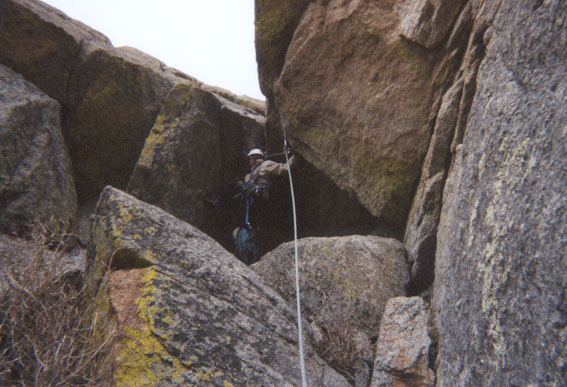
(This is me hanging from the rope in the Cave after falling; note the pack hanging from my harness)
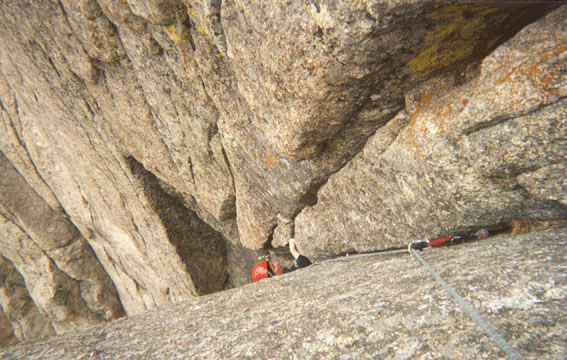
(This is what it looked like from above as Lisa turned the lip of the roof;
Lisa is standing where my left hand is in the previous picture)
We topped out and sat on top for a while. Then we headed down
the
descent and finally back to
Estes Park for some well earned seafood pasta
and wine at Sweet Basil. One
of my most enjoyable climbing days ever.
* To "lead" means
you tie into the rope, start climbing, and place
protection as you go up.
Thus, if you fall, you will fall twice the distance
that you are above you last
piece of protection + rope stretch + any slack
in the rope. Therefore, when
leading, if I were to climb up 10 feet and
place a piece of protection
and then climb 5 feet above that and fall, I
would fall approximately 13
feet. | As the name infers, to "second" means
that you climb second while
being belayed by the leader who is already on
top. There is less chance of
falling far because the rope is going directly
up to the leader. It is the
seconds responsibility to "clean" or remove the
protection that the leader placed on the way up.